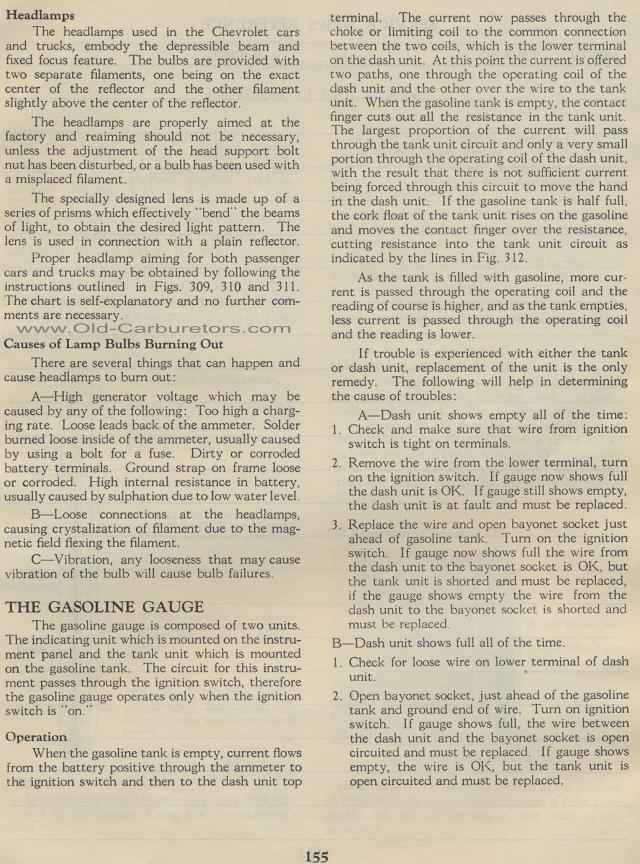1935 Chevy Headlamps
The headlamps used in the Chevrolet cars and trucks, embody the
depressible beam and fixed focus feature. The bulbs are provided
with two separate filaments, one being on the exact center of
the reflector and the other filament slightly above the center
of the reflector.
The headlamps are properly aimed at the factory and reaiming should
not be necessary, unless the adjustment of the head support bolt
nut has been disturbed, or a bulb has been used with a misplaced
filament.
The specially designed lens is made up of a series of prisms which
effectively "bend" the beams of light, to obtain the
desired light pattern. The lens is used in connection with a plain
reflector.
Proper headlamp aiming for both passenger cars and trucks may be
obtained by following the instructions outlined in Figs. 309, 310
and 311. The chart is self-explanatory and no further comments
are necessary.
Causes of Lamp Bulbs Burning Out
There are several things that can happen and cause headlamps to
burn out:
A— High generator voltage which may be caused by any of the
following: Too high a charging rate. Loose leads back of the ammeter.
Solder burned loose inside of the ammeter, usually caused by using
a bolt for a fuse. Dirty or corroded battery terminals. Ground
strap on frame loose or corroded. High internal resistance in battery,
usually caused by sulphation due to low water level.
B— Loose connections at the headlamps, causing crystalization
of filament due to the magnetic field flexing the filament.
C— Vibration, any looseness that may cause vibration of the
bulb will cause bulb failures.
THE GASOLINE GAUGE
The gasoline gauge is composed of two units. The indicating unit
which is mounted on the instrument panel and the tank unit which
is mounted on the gasoline tank. The circuit for this instrument
passes through the ignition switch, therefore the gasoline gauge
operates only when the ignition switch is "on."
Operation
When the gasoline tank is empty, current flows from the battery
positive through the ammeter to the ignition switch and then to
the dash unit top
155terminal. The current now passes through the choke or limiting
coil to the common connection between the two coils, which is the
lower terminal on the dash unit. At this point the current is offered
two paths, one through the operating coil of the dash unit and
the other over the wire to the tank unit. When the gasoline tank
is empty, the contact finger cuts out all the resistance in the
tank unit. The largest proportion of the current will pass through
the tank unit circuit and only a very small portion through the
operating coil of the dash unit, with the result that there is
not sufficient current being forced through this circuit to move
the hand in the dash unit. If the gasoline tank is half full, the
cork float of the tank unit rises on the gasoline and moves the
contact finger over the resistance, cutting resistance into the
tank unit circuit as indicated by the lines in Fig. 312.
As the tank is filled with gasoline, more cur-rent is passed through
the operating coil and the reading of course is higher, and as
the tank empties, less current is passed through the operating
coil and the reading is lower.
If trouble is experienced with either the tank or dash unit, replacement
of the unit is the only remedy. The following will help in determining
the cause of troubles:
A— Dash unit shows empty all of the time:
1. Check and make sure that wire from ignition switch is tight
on terminals.
2. Remove the wire from the lower terminal, turn on the ignition
switch. If gauge now shows full the dash unit is OK. If gauge still
shows empty, the dash unit is at fault and must be replaced.
3. Replace the wire and open bayonet socket just ahead of gasoline
tank. Turn on the ignition switch. If gauge now shows full the
wire from the dash unit to the bayonet socket is OK, but the tank
unit is shorted and must be replaced, if the gauge shows empty
the wire from the dash unit to the bayonet socket is shorted and
must be replaced.
B— Dash unit shows full all of the time.
1. Check for loose wire on lower terminal of dash unit.
2. Open bayonet socket, just ahead of the gasoline tank and ground
end of wire. Turn on ignition switch. If gauge shows full, the
wire between the dash unit and the bayonet socket is open circuited
and must be replaced. If gauge shows empty, the wire is OK, but
the tank unit is open circuited and must be replaced.

|
